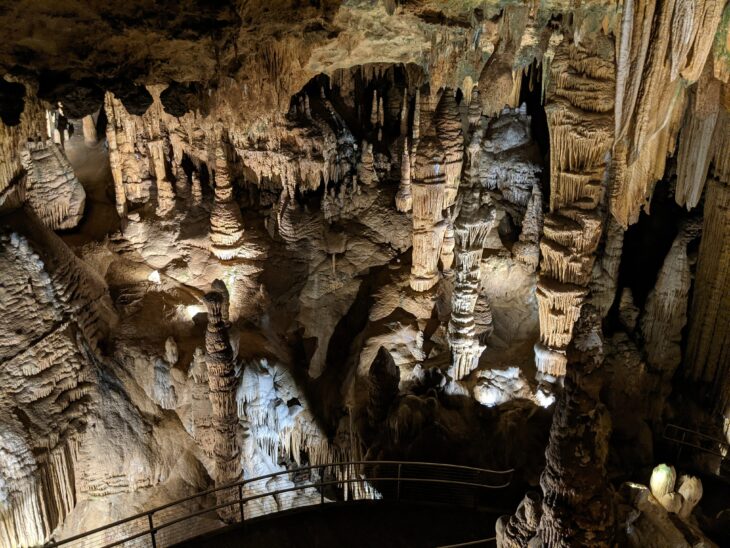When you think of caves, the image that probably comes to mind is of a dark habitat perfect for bats and other nocturnal critters. But with the large boom in cave tourism over the past century, caves like Carlsbad Caverns have become well-lit and inviting places for the general public.
The new lighting with this rise in tourism has also led to a boom in photosynthetic life known as lampenflora. Lampenflora is a German term, sometimes called “lamp-flora” in English, which refers to photosynthetic organisms growing in caves around artificial lighting systems.
These lampenflora make thin sticky layers, called biofilms, similar to the plaques that form on your teeth if you don’t brush enough. Cave lampenflora are like an annoying little sibling, getting their dirty fingerprints all over stuff and going into places they’re not supposed to be. They are difficult to remove, and can damage the beautiful natural features of the cave, like stalactites and stalagmites.
Scientists treat most lampenflora by repeatedly applying bleach to affected areas of the cave. This method produces a bad odor and can further harm the stalagmites and stalactites. Researchers have suggested an alternative method for removing lampenflora could be changing the intensity and color of artificial cave lighting systems in tourist caves.
The light we see exists in a range of colors, from warmer colors like red and orange to cooler colors like blue and purple. These different colors are caused by different wavelengths of light – warmer colors have longer wavelengths and cooler colors have shorter wavelengths. Light can also exist at different intensities, from low and dim lighting to brighter, more intense light.
Lampenflora consist mainly of photosynthetic bacteria and algae. These organisms capture light energy with special molecules, called pigments, that absorb specific wavelengths of light. Just like plants, photosynthetic bacteria and algae are often green because their pigments absorb red and blue light and reflect green light. Scientists have therefore hypothsized lampenflora growth could be dampened by reducing the amount of blue or red light available to them for photosynthesis.
A team of researchers from New Mexico Tech, the National Park Service, and the National Cave and Karst Research Institute tested this hypothesis by changing the lighting system within a tourist cave. The authors of this study sampled lampenflora biofilms at six sites in Carlsbad Caverns. Three of the sites had normal lighting, and three of the sites had lighting with less blue light.
The researchers collected samples from each site 5 times over the course of a year. They identified the species of lampenflora by sequencing genes from algae and bacteria in the cave and comparing them to genetic material from known species. They found cyanobacteria were the most common bacteria in the lampenflora, and Chlorophyta and Ochrophyta were the most common algae.
Cyanobacteria are bacteria that use photosynthesis to convert light into energy they can use for different metabolic processes. Chlorophyta are green algae and Ochrophyta are brown algae and their relatives. Both types of algae perform photosynthesis, but cyanobacteria and Chlorophyta contain a pigment that reflects green light and Ochrophyta contain a pigment that reflects red light. All three of these are relatively common photosynthetic organisms you could find growing in ponds or other wet, well-lit places.
The researchers measured lampenflora growth in the sites over the course of a year using a method called reflected-light spectrophotometry. They used this method to shoot light at the biofilms and then measure the color of light they reflected back. They reasoned since lampenflora biofilms are green, a surface reflecting more green should mean more lampenflora growth.
The team found different bacteria and algae were present at the sites with cooler and warmer lights. They also found algae dominated the lampenflora community over the course of the year. However, their reflected-light spectrophotometry did not show statistically significant differences in lampenflora growth based on the color of the light. They interpreted this result to mean changing the color of cave lighting was not enough to treat lampenflora growth alone.
The authors concluded changes in lighting should be combined with other cleaning methods like bleaching to successfully stop lampenflora growth. This is like how using a better toothpaste can help clean the biofilms off your teeth, but you still need to brush! They suggested future work could consider compounding variables like foot traffic, since the researchers could not control who accessed the research sites or how often.


